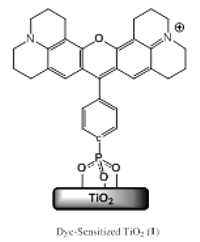
*Institute of Organic Chemistry, Regensburg University, Regensburg 93040, Germany, and
**Institute of Inorganic Chemistry, Regensburg University, Regensburg 93040, Germany

 |
Maria Cherevatskaya*, Stephan Dankesreiter**, Arno Pfitzner**, and Burkhard König*
*Institute of Organic Chemistry, Regensburg University, Regensburg 93040, Germany, and |
 |
Visible light photocatalysis is a topic of increasing interest for many applications. One way of utilizing the visible range of the solar spectra is the combination of organo- an photoredox catalysis as pioneered by MacMillan.[1] Using MacMillan's catalyst in conjunction with inorganic semiconductors as sensitizers, we have investigated the asymmetric C-C coupling of octanal with different bromo-substrates.[1,2]
The range of investigated semiconductors includes the well-known blank TiO2 (P25), dye-sensitized TiO2 (1) as well as novel PbBiO2Br semiconductors. The PbBiO2Br semiconductor was used in two modifications - nanoparticles and bulk material, which have band gaps of 2.56 eV and 2.47 eV, respectively and can be irradiated with 440 nm LEDs. TiO2 was sensitized by the Phos-Texas Red dye, which was immobilized on the surface and showed an absorption maximum at 560 nm.
The products could be obtained in good to very good yields of up to 84 % (PbBiO2Br nano/2-bromodiethylmalonate) and with excellent enantioselectivities of up to 96% (PbBiO2Br nano/bromoacetophenon).[3]